VRBS ROMA imitations (AD 330- 340)
This site has six pages of imitations.
1) An overview which includes more-detailed look at GLORIA EXERCITVS
2) This page on VRBS ROMA , 3) CONSTANTINOPOLIS, 4) the "Two-Victories" type found in the Balkans and north,
5) Other types before 340, and 6) Types from 340-347.
The very common Roman coin type VRBS ROMA is commonly found on ancient imitations.
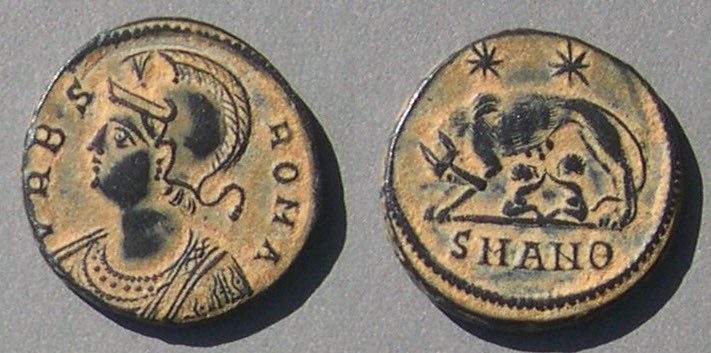 This is an official prototype is 17 mm and 2.92 grams.
This is an official prototype is 17 mm and 2.92 grams.
VRBS ROMA, Roma facing left in plumed helmet
Wolf and twins. Wolf left, head back, suckling the twins Romulus and Remus, two stars (usually assumed to represent the Dioscuri) above.
Mintmark in exergue: SMANΘ
RIC VII Antioch 113 "336-7"
This prototype was extensively imitated in the west, especially in Britain. Small and ill-made pieces exist by the thousands. Many show the distinctive green patina (or ugly corrosion) of English soil. Few are sharply struck and well-centered. A pleasing barbarous VRBS ROMA would be a prize.
The examples below were (probably) all found in England. I believe the majority of VRBS ROMA imitations are from England, but the selection below may be biased because of my sources. However, I am not aware of eastern hoards having such imitations. The CONSTANTINOPOLIS page has three imitations found in a hoard of perhaps 1000 official pieces which was probably found in the Balkans, but that percentage is extremely small compared to the fraction of imitations in English groups.
Here is an image to give you are feeling for the size of imitations which are smaller, or much smaller, than the originals:
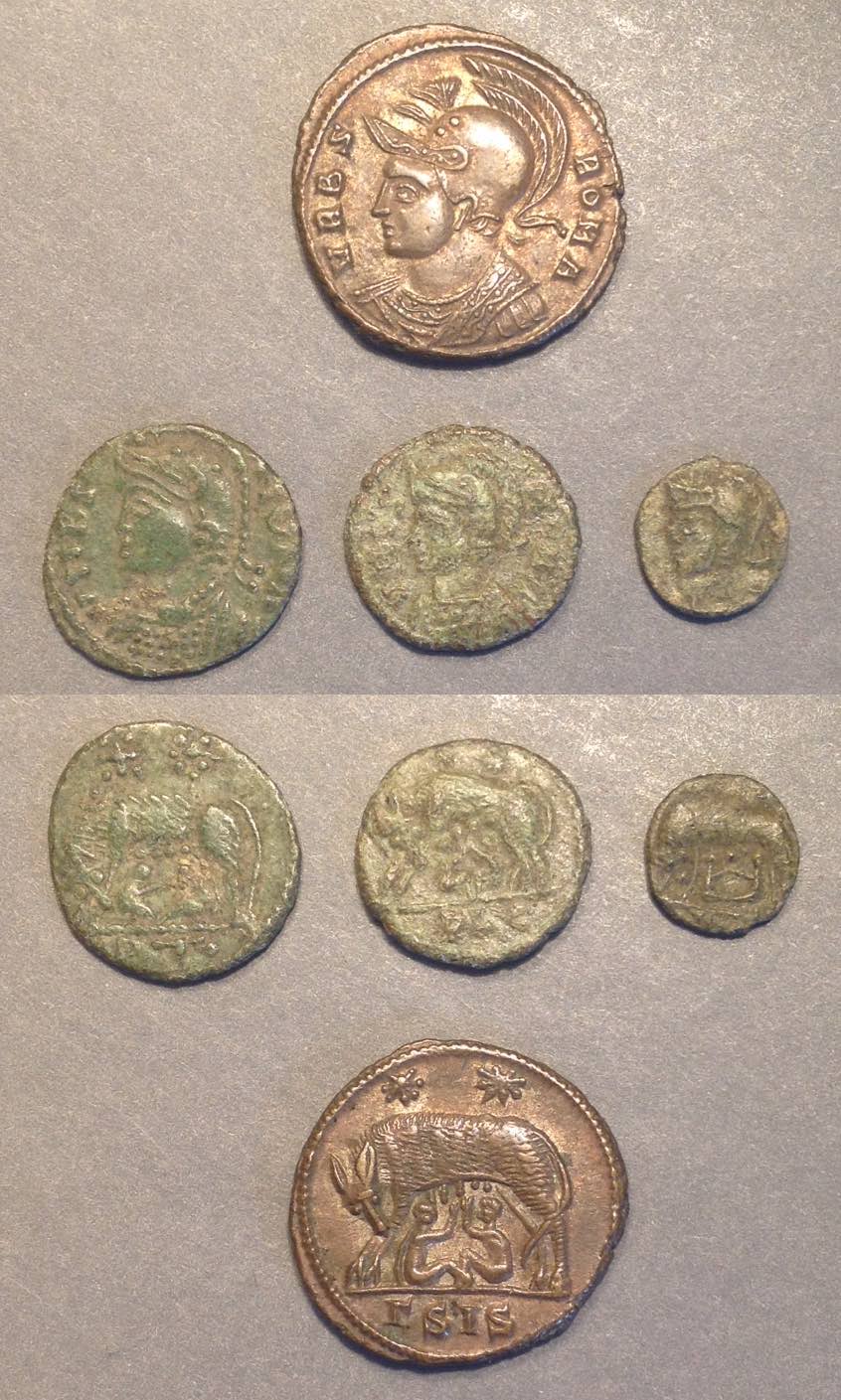 Another official coin, this time from Siscia, with three imitations.
Another official coin, this time from Siscia, with three imitations.
The large official coin is 19 mm and 2.87 grams. (Many official coins are a millimeter or two smaller.)
RIC Siscia 222 "330-3"
The smallest one is 8.5 mm and 0.36 grams. It is crowded, but remarkably well centered.
VRBS ROMA/wolf and twins.
The imitations are described individually below.
 (Seen above)
(Seen above)
15 mm. 0.99 grams.
Good style, even green patina, crude lettering.
/stars of crosses with dots in the quarters
In exergue: P T •
From Baldwin's in London, 1988.
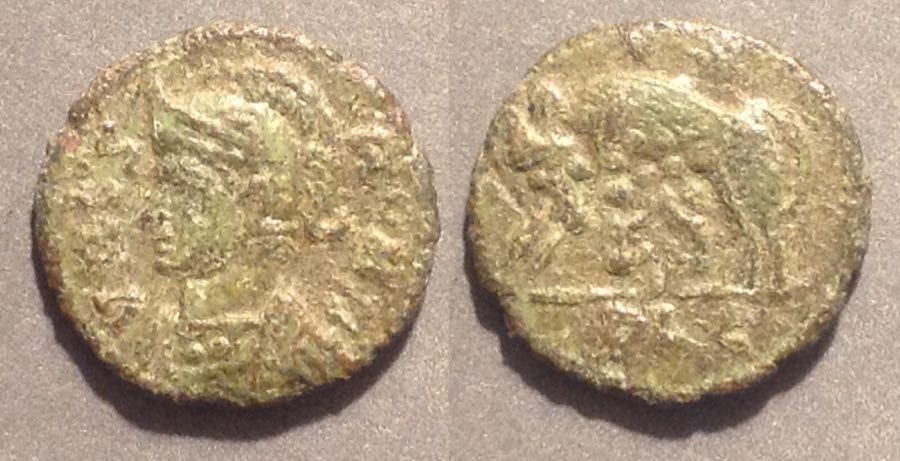 (Seen above)
(Seen above)
13 mm. 1.04 grams.
PLG in exergue.
Excellent style and lettering, but too small to be official.

(Seen above)
9 mm. 0.36 gram.
A very small coin remarkable for its good centering.
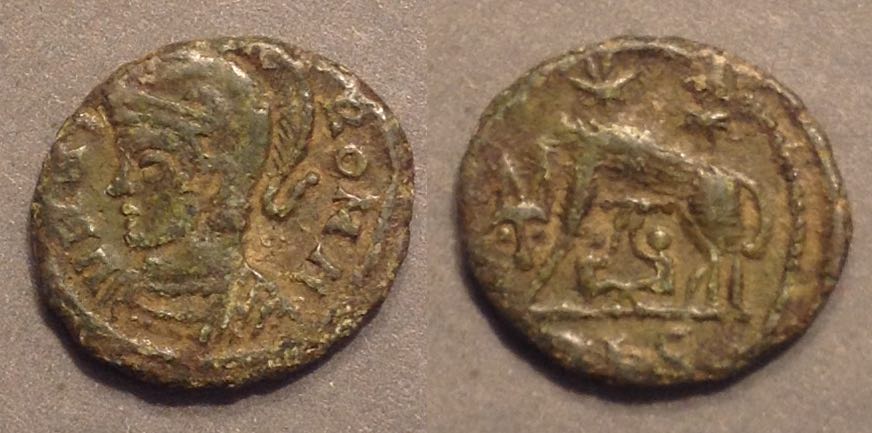 14 mm. 1.04 grams.
14 mm. 1.04 grams.
VRBS ROMA clear.
In exergue, only the final letter "C" is clear, but probably PLC.
From Malter, 1990.
Most imitations are 15 mm or less and in poor condition. Here are six of the better (!) ones from hundreds seen at English coin fairs.

Six VRBS ROMA imitations, 14-12 mm.
Mintmarks, left to right: TRS, • PLG, PLG, missing, PLG, PLG • .
Mules. Those who made unofficial imitations did not seem to care much about making sure obverses and reverses were combined properly as on official coins. There are "VRBS ROMA" obverses with Victory reverses that belong on the CONSTANTINOPOLIS type. When a coin has an obverse and reverse that do not belong together it is called a mule or hybrid. Here are a few.
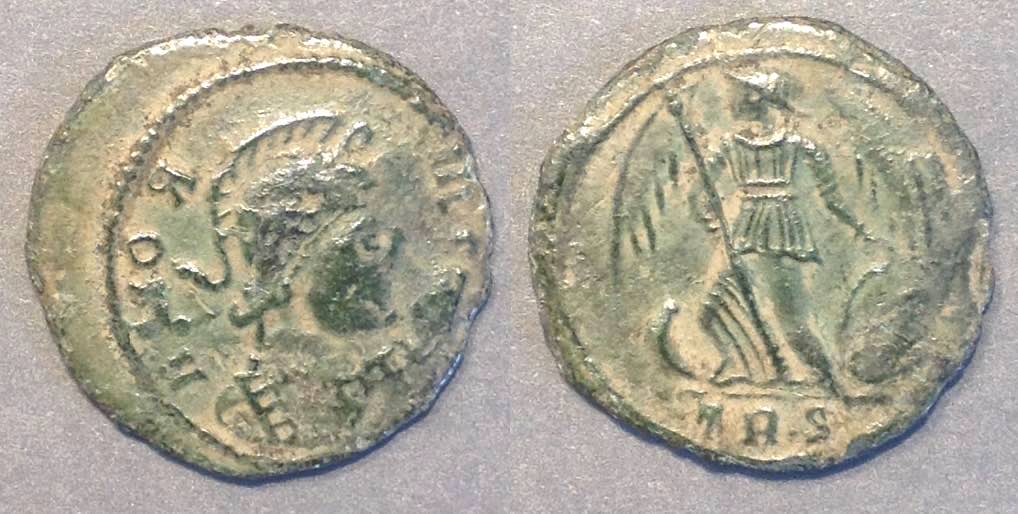 18 mm. 1.73 grams. Remarkably large!
18 mm. 1.73 grams. Remarkably large!
VRBS ROMA obverse with ROMA retrograde and the rest blundered or doublestruck enough to be illegible, and a crude bust right (instead of the usual left).
Beautiful and good style Victory reverse,
TRS in exergue for Trier.
A "hybrid" or "mule" (the reverse does not belong paired with the obverse) for types but its greatest interest is the style. The reverse Victory looks official and very well-done. The obverse is the wrong type, retrograde, and cartoonish. Remarkably inconsistent!
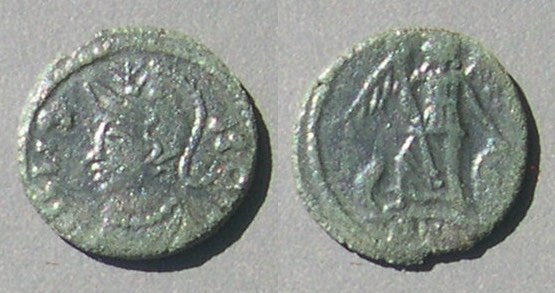 13 mm. 1.24 grams.
13 mm. 1.24 grams.
This is much too small to be official.
The bust left is reasonably well done. The legend is crude. It has enough letters to suggest
VRBS ROMA, but is not complete or clear.
The Victory is well done.
Perhaps PTR in exergue.
The dies fit the small flan.
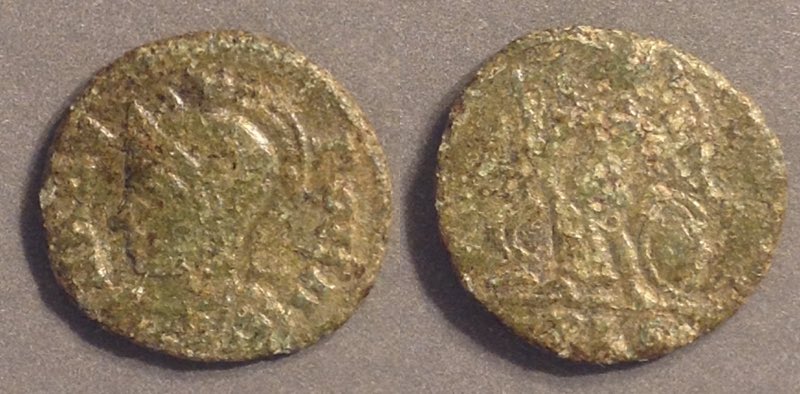 14-13 mm. 1.29 grams.
14-13 mm. 1.29 grams.
The dies fit the flan, but are not deeply engraved, so the strike is weak.
The legends are almost legible.
12 mm. 1.02 grams.
The obverse is retrograde with bust right (instead of left) and ROMA backwards.
The reverse is the GLORIA EXERCITVS two soldiers and two standards reverse.
This coin, and thousands of others about this size that I have seen at English coin fairs, are far too small to have been regarded as official by anybody. However, their numbers prove they had value and were used.

8 mm. 0.35 grams. Tiny!
Pearl-diademed head right
Wolf and twins
Mintmark, if any, off the flan.
Heads, when identifiable on imitations of this period, are usually of Constantine II, although Constans or Constantius II are possibilities.
Comment. Coins like these imitations have been found by the thousands in England. I wonder if the existence of so much "small change" proves that fourth century Britain had a large and active monetary economy in a way that earlier times did not. If a wretched coin like this one was worth making and worth enough to buy something, transactions of small amounts must have been common. Gold coins and denarii are too valuable to spend on one glass of watered wine at a pub. Gold and silver coins, however abundant, don't prove transactions were happening frequently--they also serve as a store of wealth. It is common and worn smaller denominations that evidence frequent transactions.
You have just finished the page on VRBS ROMA imitations.
Continue with the page on CONSTANTINOPOLIS imitations.
Return to the page on GLORIA EXERCITVS imitations and official types of 330-340. (Page 1)
Skip ahead to the page on imitations from AD 340-348.
Return to the main page on Roman imitations.
 This is an official prototype is 17 mm and 2.92 grams.
This is an official prototype is 17 mm and 2.92 grams.  Another official coin, this time from Siscia, with three imitations.
Another official coin, this time from Siscia, with three imitations. (Seen above)
(Seen above) (Seen above)
(Seen above)
 14 mm. 1.04 grams.
14 mm. 1.04 grams.
 18 mm. 1.73 grams. Remarkably large!
18 mm. 1.73 grams. Remarkably large! 13 mm. 1.24 grams.
13 mm. 1.24 grams. 14-13 mm. 1.29 grams.
14-13 mm. 1.29 grams.
